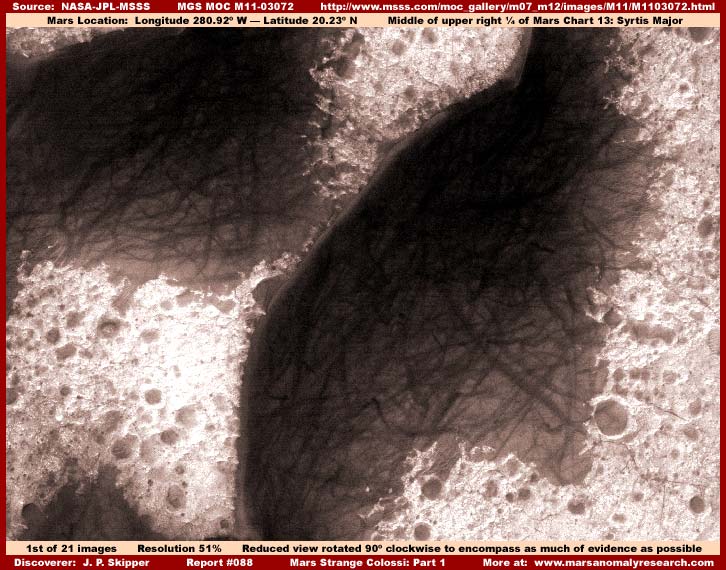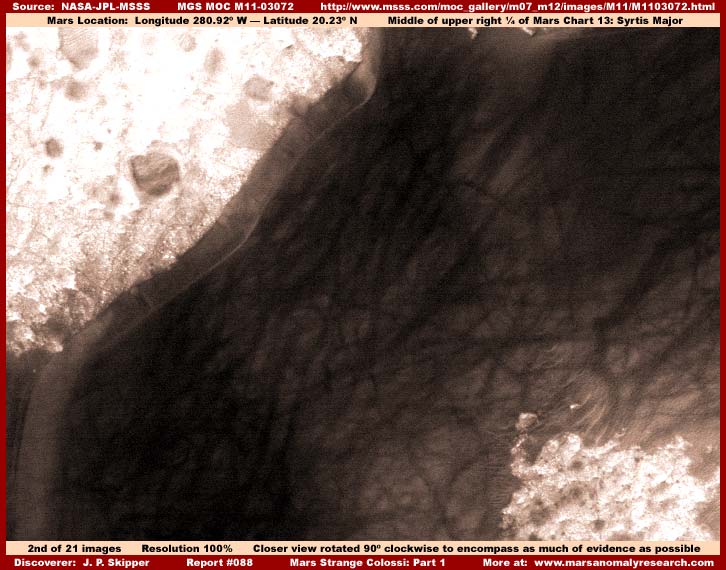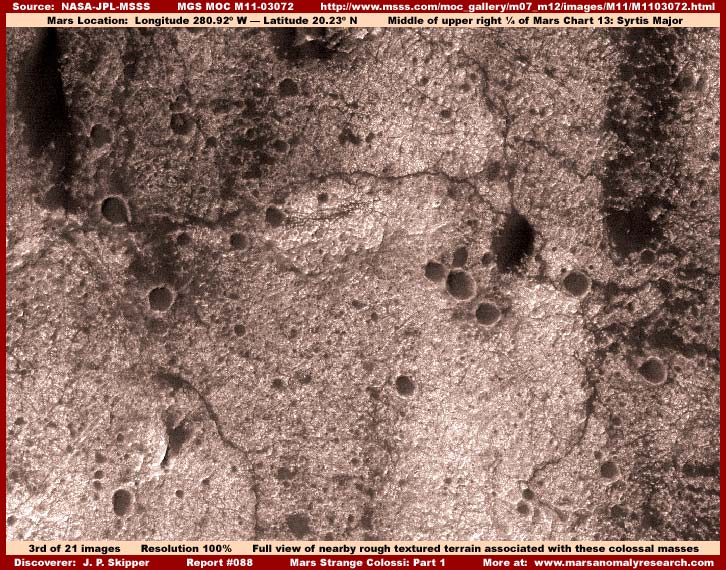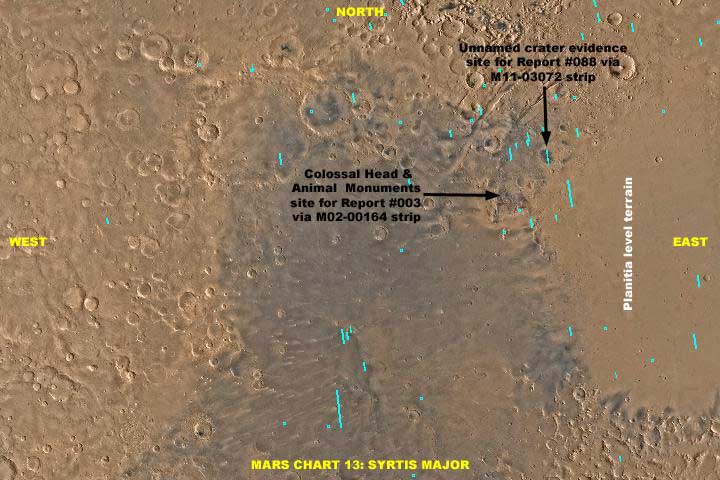
MARS STRANGE COLOSSI
Part 1 of 5
Report #088
July 11, 2005
PART 2 — PART 3 — PART 4 — PART 5

If you aren't already aware of it, it seems like every elevated rounded or ridge looking form with some surface texture smoothness to it on Mars is officially identified as a dune or dunes or dune fields regardless of how it may appear to look like something otherwise and/or different from one site to another. This approach conditions and tries to lead and guide perception along desired non-questioning paths so that any explanation for what you see is geological and therefore normal to some extent in origin. It of course also reinforces the official mantra that Mars is a dry as dust dead world and no need for anyone to think outside the prescribed box except to perhaps briefly note that the evidence may look a little strange.
Well we're definitely going to be needing to think outside the box with the type of strange evidence presented here. Once again I'm going to be trying to convey to you at least the question of a relationship between different looking types of evidence. In fact, I'm going to try to show you that some of this evidence is actually the same thing, just dynamic and changing and seen in different shapes. This will be very difficult with only limited report imaging but I'm going to try.
Even if I fail at this, at the very least I think you will be able to see that some of this evidence is mostly definitely not sediment or sand dunes of any kind. However, please understand that I am not trying to convey a message that there aren't dunes on Mars. There are and plenty of them. But, what needs to be understood is that something additional and far more complex is going on with the type of evidence you will see here in this report and I'm just trying to get you to be aware of this and regard this with a questioning eye rather than lump everything together as the official interpretation has done with the sand dune concept.
The above first image is evidence from within a fairly small crater (no official name stated) in the Syrtis Major region in the mid-latitudes of Mars north of the equator. You should perhaps be aware that this crater site sits in transitional terrain. To the west of it is rough elevated country and to the east and south of it is a large track of pretty much level planitia type land. It is also in the same general area as and not too far northeast of the great colossal monument evidence in my early Report #003 title "Colossal Head & Animal Monuments" and other civilization evidence I've reported on there in late year 2000.
Further, it is the same evidence, just seen from a different angle and in a different official science data strips, in my early Report #017 titled "A Puzzle! What is This?" and Report #049 titled "When Dunes Are Something Else." Obviously, with this much reporting exposure by me, I am of the opinion that this is very important evidence that needs to be questioned and better understood.
In the above first image, we are looking directly down on colossal size dark light absorbing masses that contrast very strikingly with the highly light reflective albedo terrain they sit in. As you can also see, the dark objects as seen here in this scene are also apparently semitransparent allowing a partial view into their interior but not so much as to provide a view through and below them of the ground on which they sit. Note that the dark objects essentially absorb light rather than reflect it as does the surrounding terrain and not much in the way of object surface can be seen because of that giving them their very strange look. This semi-transparency, dark light absorbing quality is very typical of these massive forms.
Likewise, note the tangle of dark crisscrossing streaks associated with these forms. The official interpretation is that these are the tracks of dust devils disturbing the top lighter color dust surface layers and exposing the darker soil layers underneath in their passing. This of course again drives home and reinforces the concept and conditioning that Mars is this dry as dust dead world.
However, let me point out that not a single one of the many dark streaks in this scene passes from inside these dark light absorbing bodies crossing across its outer perimeter and into the surrounding high albedo terrain. Further, there is no evidence of dark streaks in the surrounding terrain at all. It is the same with the evidence in the older previous Reports #017 and #049. This to is a distinct and typical characteristic of these masses. What ever the dark streaks are they do not appear to be surface features but are evidence of something contained within the interior body of the mass that are revealed only by its semitransparent state.
Another less obvious but still identifiable and typical feature is the fact that the dark masses are most definitely elevated forms as opposed to depressions in the ground or something flattened on the ground. In the mass on the right in the above first image, note the ragged edge perimeter on the right of the mass and the much more firm solid edge perimeter line on the left. Also note the increased mass translucency on the right and the lessening of it moving over toward the left. Finally note the band of light reflection low off of the left side edge of the mass surface.
All of these factors tell us that this is a elevated object that rises in height quickly near the more sharply defined left edge and then makes a long slow taper down to the ground and thinning out there on the more ragged right edge. The increased depth of the body near the left edge is demonstrated by the darker less translucent interior on the left and the light reflectivity off of that elevated side while the decreasing height moving down a long slope toward the right edge results in thinning and more translucency and reflectivity there. A point I'm trying to make here is that this describes a form with its primary mass leaning to our left with it elevated height folding over the ground there forming a sharp perimeter edge and stretching the right portion into a long slope and creating the right ragged edge stretched look.

The above second closer view is actually just the full official view without any additional zoom factor by me. The official view of this evidence appears very much closer than normal and, in my opinion, that is intentional because it actually obscures more than it reveals of these already huge objects. This is because it is difficult to take in the entire evidence scene (a wider portion of which I have provided in the 51% reduced view first image) and it also effectively obscures the light color high albedo surrounding terrain with too much light color over saturation. Any sense of scale here is destroyed because nothing this close and on such strange unfamiliar objects is very recognizable.
Here's an analogy. If one could position one's self millions miles out from our Sun and could gaze upon it, one could clearly see that it is a enormous round orb in space. However, if one positioned one's self only a hundred miles out from the Sun's surface and could actually gaze upon it from there, one would see only a massive flat wall stretching off in the distance up and down as well as right and left. In other words, the Sun remains what it is but our perception of it is distorted by being too close to it.
Even so, the closer view does help assist us in identifying the object's semi-transparency quality and the elevation on one side and the long downward sloping features on the other side a bit more. This again demonstrates that we are looking not just at an elevated form but one that appears to be leaning its primary height to our left. The truth is that, if these dark objects had a more solid appearing light reflective surface at the time these shots were taken, they would indeed appear very wind swept and contoured "dune" like in their general appearance. So one can perhaps understand when the official identification of these objects and others like them in this crater is so readily that they are as part of a "dune field."
To give you an idea of what we are really looking at here with this too close official exposure in the first two images here, take a look again at my first image in Report #049 titled "When Dunes Are Something Else" where I have briefly examined this subject matter there. The "dunes" you see in that report's first image with the solid light reflective surface are the same shapes as the semitransparent light absorbing masses you also see in that report and above, they just don't look the same here because of the light absorbing and transparency factor obscuring the whole shape's true outline. Yet, I'm proposing that these objects are all the same.
In fact, I'm proposing that these objects are active and dynamic and can control their general shape within the confines of their ground anchor point appearing generally dome shaped, oblong dome shaped, and leaning their primary mass to one side as seen in the above too close images effectively mimicking wind swept dune shapes when their surface has later developed its solid appearing light reflective surface. Yes, I am also proposing that they can additionally control their surface texture and general color from semitransparent and light absorbing dark to a solid appearing light reflective surface texture.
I am also proposing that these objects turn dark and light absorbing semitransparent probably to gather solar energy within their body and that they may then use that accumulated energy to repower themselves and/or power altering their general shape. I suspect that the streaks seen within the body of any one of these masses in its light absorbing semitransparent state may be evidence of energy collectors (perhaps living) revealed by the transparency or a release of energy like visible plasma fields as the object goes about alteration and/or re-energizing. I suspect that these forms also have the ability to move across the ground to a limited extent but that is admittedly pure speculation unsupported by any of the visual evidence.
I also suspect that these objects can mimic or be influenced to mimic surrounding terrain like real dunes to sort of visually blend in with them as a camouflage system and/or to please esthetic values not our own. If true, then obviously these otherwise independent objects also have the capacity to work in unison with each other to create multiple very similar looking shapes or they are externally compelled to work toward that end by outside influences. This may imply that these objects are alive and have intelligence and/or they are externally programmed and manipulated to a desired end by external intelligence or some combination of both.
At the very least, here in this image with light absorbing semi-transparency states revealing these crisscrossing dark streaks within the circumference of these great object's form, they certainly don't look much like any sediment dune I've ever seen. After all, how often do any of us see a dark but semi-translucent light absorbing dunes here on Earth? The last time I checked, accumulations of geological sediment material into dune shapes never has any transparency quality must less crisscrossing streaks within them. In my opinion, a lot of this type of evidence seen on Mars has nothing to do with "dunes" of any kind. In my opinion, what we are looking at here is either life itself, or it is associated with the manipulations of life, or both.
The visual evidence isn't conclusive here in this multipart report and I cannot offer conclusive answers to all these questions that obviously come to mind arising out of this evidence. Yet, I believe that I am on the right track enough to report this to you and can perhaps offer some increased insight enough to at least warrant a questioning attitude and the understanding of a need to resist blindly accepting the official sand dune explanation. Wait until you see all the evidence and decide for yourself.

The above third image demonstrates a sample area of terrain in the same image strip nearby the huge dark masses except that now the light color over saturation high albedo reflectivity with its obscuring quality has now been darkened and subdued a bit in the image to reveal a better look at the ground detail. Please note the relatively rough nature of this terrain and the absence of any streaks in it. This is very typical of the sites where these colossal forms are found.
Note the fact that the terrain around and out from these dark masses with their clearly defined perimeters does not show any evidence of significant loose sediment accumulation into piles and drifts so typical of dune fields that we are familiar with here on Earth. In other words, each one of these colossal dark masses is like an island with insufficient nearby evidence of terrain sediment accumulation in amounts significant enough to either contribute to generation of these great masses or provide any evidence of wind erosion of these great elevated forms.
For example, if there had been winds strong enough to sculpt these forms and scour and blow away all other sediment in the surrounding terrain, then where is the streaming evidence of strong wind blown sediment on the downwind lee side of the huge elevated dark masses that would also have to be there but obviously isn't? You can't have your wind blown cake and eat it to! You will see the lack of this evidence again and again in the other evidence images in this report. The point is, how in the world can scientist accept labeling these objects as wind blown loose particulate sediment dunes or portions of dune fields when they are obviously not that but something else tough and cohesive with physical properties denying such interpretation just as it denies the effect of the wind?
However, the main insight I want to convey to you here with this last third image is that, despite the already huge apparent size of the evidence objects in this image strip, the truth is that this scene is far more distant than the statistics would lead us to believe. The tiny winding dark thin continuous trails down there in the above third image are no doubt very distantly seen river drain erosion systems. Further, although the distance is far too great to be seeing normal very large size individual objects down there, the file size on this particular image is abnormally large. As I have explained a number of times in other reports, this often indicates that the graphics software is counting a very large number of tiny solid objects down there in this scene. In this particular case, that might just indicate a lot of rough individual geology encompassed by the very distant wide field of view but it also may indicate something more to.
This evidence gives you an insight into just how very distantly viewed this terrain is really being seen at. This is very typical of this kind of evidence and how it is effectively obscured. That knowledge in turn reveals, not only that the official statistics cannot be trusted as to distance and scale, but that the huge dark objects thought to be gigantic to start with are really far more colossal than originally suspected. We can't know for sure since the distance has been so compromised by manipulation and with familiar frames of reference eliminated but it is quite possible that entire cities could fit within these colossi dark mass shapes and their colossal circumferences just to give you an idea of scale.
Meanwhile, as a matter of reference before concluding this Part 1 portion of this multipart report, I'm going to include the Syrtis Major region graphic below with the location of this crater evidence site pointed out on it as well as the nearby older Report #003 "Colossal Head & Animal Monument" evidence also pointed out on it. It is interesting to recognize that this very different but colossal size evidence shares a fairly close proximity to each other.

So what we've covered in this Part 1 is that these massive dark light absorbing and semitransparent masses with their self contained streak and unusual shape evidence give colossal size a new meaning by any standard here on Earth and their official descriptions as dunes or portions of dune fields is completely inadequate. You will see in the subsequent other parts of this report that these often gigantic masses not only can possibly change their surface texture and transparency but can also change their general shapes within their anchor points forming new unique appearances.
Ultimately, the big question may be, do these things represent living biology or advanced technology or both? What ever the answer may be, this evidence certainly gives 'strange" a new dimension in human interpretation. Now let's move on to:
DOCUMENTATION
http://www.msss.com/moc_gallery/m07_m12/images/M11/M1103072.html: This link will take you to the MGS MOC M11-03072 science data strip used in this report. Note that all strips work and will serve to verify the evidence. However, the third listed straight oriented higher detail but slower loading GIF strip has been flipped vertically and horizontally at official level and will need flipping back to achieve the correct orientation. Likewise, after making these corrections, I rotated the image 90º clockwise to get more evidence into my imaging. This however did not distort any of the detail.
http://www.msss.com/moc_gallery/ab1_m04/images/SP123008.html: This link will take you to the MGS MOC SP1-23008 official science data strip. This strip shows basically the same evidence portion as in the above M11-03072, just taken at a different earlier date and imaging angle. That evidence was presented in my older year 2001 Report #017 titled "A Puzzle! What is This?" but offers a very good view of the evidence.
, Investigator
![]()